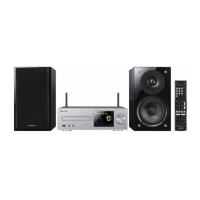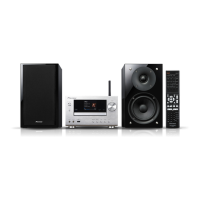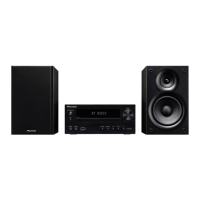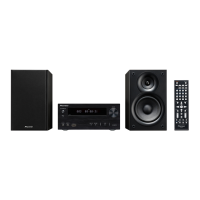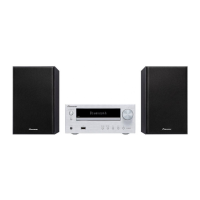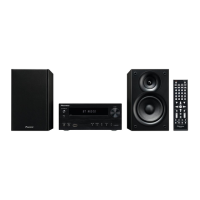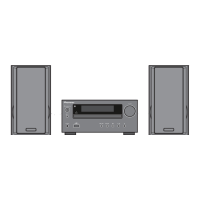Do you have a question about the Pioneer X-HM71-K and is the answer not in the manual?
Overview of the receiver system and its components.
Instructions for removing and attaching the speaker system's front grille.
List of accessories included with the receiver package.
Guide on how to insert batteries into the remote control.
Specifies the effective distance and angle for remote control operation.
Identification and explanation of controls and indicators on the receiver's front panel.
Description of information shown on the receiver's display screen.
Detailed layout and function of each button on the remote control.
Instructions for connecting FM, AM, and WLAN antennas to the receiver.
Guidance on connecting the optional Bluetooth adapter for wireless audio.
Steps to connect the WLAN antenna for wireless network access.
How to properly connect speaker wires to the receiver terminals.
Information on connecting an active subwoofer to the receiver's pre-out socket.
How to connect external audio sources like a TV using audio cables.
Steps to connect USB devices for playing audio files.
Guide to establishing a wired or wireless network connection for online features.
How to connect external audio devices using the receiver's auxiliary input.
Initial setup procedures for customizing receiver settings upon first use.
How to set the internal clock for timer functions and accurate time display.
Configuration of the timer to automatically turn on the receiver and play a selected source.
How to set the receiver to automatically switch to standby mode after a specified time.
Overview of basic operations like input selection and network function access.
Procedure to select and play audio from connected auxiliary devices.
Guidelines for connecting and using headphones with the receiver.
How to adjust the brightness level of the receiver's display.
Instructions for adjusting the listening volume using the receiver or remote.
How to temporarily mute or unmute the audio output.
Adjustments for bass, treble, P.Bass, and equalizer settings to customize sound output.
List of compatible iPod, iPhone, and iPad models for playback.
Step-by-step guide to connect iPod, iPhone, or iPad to the receiver.
Specific instructions for connecting devices to the iPod/iPhone dock.
How to view iPod/iPhone images on a television set by connecting the receiver.
Connecting iPod, iPhone, or iPad via the USB terminal for playback.
How to select and play audio content from connected iPod, iPhone, or iPad.
Enjoying music wirelessly by connecting a Bluetooth-enabled device.
Procedures for connecting the optional Bluetooth adapter to the receiver.
How to set or change the PIN code for Bluetooth pairing.
Steps to establish a wireless connection between the adapter and your Bluetooth device.
How to select and play music from a connected Bluetooth device.
Information about the Air Jam application for group playlist creation.
Instructions for inserting and playing standard CDs and CD-R/RWs.
Features for playing MP3 and WMA files, including track search.
Options for repeating a single track, all tracks, or programmed sequences.
How to play tracks on a disc in a random, shuffled order.
Creating custom playback sequences by selecting specific tracks.
How to view elapsed and remaining playback times for the current disc.
Playing MP3/WMA files organized in folders on a disc.
Explanation of how folders are numbered and selected for playback.
Guide to selecting and playing audio files from a connected USB storage device.
How to find and listen to radio stations streamed over the internet.
Steps to connect the receiver to a local area network for internet access.
Registering and accessing favorite music tracks and radio stations.
Managing favorite content using the Favorites function.
Customizing internet radio settings and registering external stations.
Configuring wired or wireless network settings for internet connectivity.
Using Wi-Fi Protected Setup for secure and simple wireless network connection.
Establishing a wireless connection by entering a PIN code.
Manual network setup using a computer's web browser.
Applying Wi-Fi settings from an iPod, iPhone, or iPad to the receiver.
Customizing the receiver's name for network identification.
Restricting access to internet radio and favorites with a password.
Overview of playing audio files stored on network-connected PCs or components.
Information on compatible devices and servers for network playback.
Explanation of the DHCP server's role in network connectivity.
Steps to authorize the receiver for accessing music servers.
How to select and play audio files stored on network music servers.
Tuning into FM and AM radio stations using automatic or manual methods.
Adjusting FM reception to mono for better sound quality with weak signals.
Storing frequently listened radio stations for quick recall.
How to select and tune into saved radio station presets.
Assigning custom names to saved radio presets for easier identification.
Adjusting noise reduction settings for AM radio reception.
Explanation of the Radio Data System and the information it provides.
Finding radio stations based on program types using RDS.
How to view various RDS data like station name and program type.
Solutions for common operational problems and malfunctions encountered with the receiver.
Important safety and usage guidelines to prevent damage or hazards.
Instructions for safely cleaning the receiver's exterior surfaces.
Guidelines for proper storage and cleaning of discs to ensure playback.
Technologies and considerations for using network streaming features like Internet Radio.
Information about Microsoft's Digital Rights Management for protected content.
Details on the Digital Living Network Alliance certification and its implications.
Supported file formats and potential playback issues over a network.
Legal notices regarding third-party content services and subscriptions.
Expected performance and potential issues during network playback.
Steps to authorize the receiver for accessing music servers.
Warnings about potential interference from devices operating on the same frequency band.
Recommended usage environment and limitations for optimal performance.
Explanation of how radio waves reflect and affect reception quality.
Guidelines for safely connecting external devices to the receiver.
List of audio file formats supported by the receiver for USB and network playback.
Compatibility information and considerations for using Apple devices.
Details on Wi-Fi connectivity and the Wi-Fi CERTIFIED logo.
Technical details including power output, dimensions, weight, and accessories.
| Audio Channels | 2.0 |
|---|---|
| Power Output | 50 W per channel |
| RMS rated power | 100 W |
| AirPlay | Yes |
| Headphone outputs | 1 |
| Headphone connectivity | 3.5 mm |
| Tuner Type | FM |
| Preset Stations | 30 |
| Bluetooth | Yes |
| Internet radio | Yes |
| Weight | 5.5 kg |
| Audio Formats Supported | MP3, WMA, WAV |
| Connectivity | USB, Bluetooth |
| USB port | Yes |
| Speaker Impedance | 4-16 ohms |
| Impedance | 4 Ω |
| Input Sensitivity/Impedance | 500 mV/47 kΩ |


